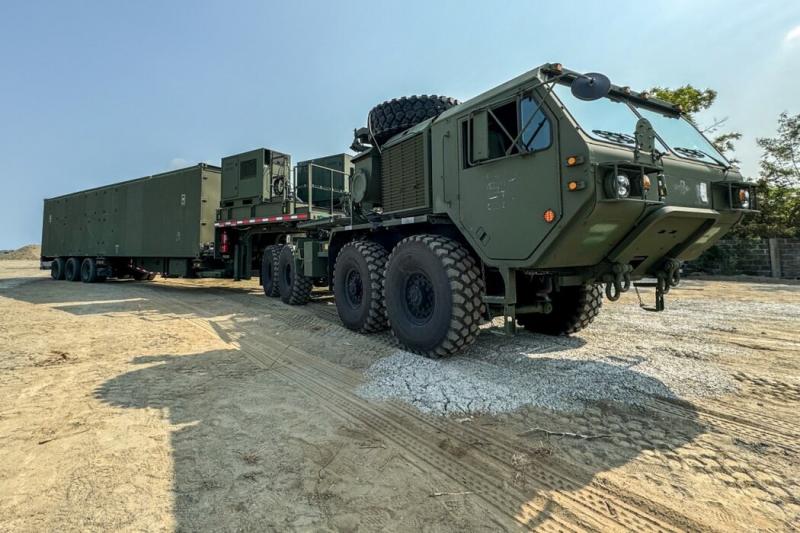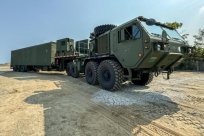
In the joint military exercise with the Philippines last month, the US Army deployed a new hidden weapon that could be hidden in the open place.
It is called "Typhon" (Typhon), which is composed of a modified 40 -foot (about 12 meters) container, which can hide up to four missiles that rotate upward.It can load weapons, including Tomahawk, and "Tomahawk" is a cruise missile that can crack down on land targets and maritime vessels about 1850 kilometers.
According to the 1987 medium -range missile treaty, this weapon and other similar small mobile launchers were illegal five years ago.The treaty banned the US and Russian troops from having a range of land -based cruise missiles or ballistic missiles between about 482 kilometers and 5470 kilometers.
In 2019, President Trump withdrew from the treaty because the United States believed that Russia had been violating its terms for many years.However, U.S. officials said that the continuous expansion of China's long -range missile weapon libraries is also one of the reasons why the Trump administration decides to withdraw.
This decision enables the Pentagon to build a weapon that is now ready to fight against Chinese.At the same time, the US Marine Corps leaders are also reflecting on the modern war.They suggest to eliminate some heavy and bulky weapons -such as 155mm howitzers and tanks, and they believe that in the Pacific, these weapons can hardly be used when they fight against the Chinese army -use car anti -ship missiles, etc.The weapons replaced.
At that time, there were no land -based anti -ship weapons.However, the troops in other countries have already available.Then, in April 2022, the Ukrainian ground forces used similar weapons -the "Neptune" anti -ship cruise missiles launched from the truck sinking the Russian "Moscow" cruiser in the Black Sea.
Although the attack on the "Moscow" was successful, a group of retired naval Marines generals publicly criticized the Marine Corps to prioritize a plan to develop similar weapons at the cost of sacrificing more traditional weapons.They said that the Marine Corps focused on China and ignored other potential threats. Moreover, giving up tanks and some heavy artillery will cause the Navy's Marine Corps to be caught off guard in other parts of the world.
At the National Defense Author Group Meeting in December 2022, General David Berje, then the highest general of the Marine Corps, acknowledged that he was criticized by his former colleagues, but he said that his decision was based on retirement.The information report that personnel cannot get.
The US military and cultural leaders believe that mainland China plans to use diplomatic means -or use force when necessary -to fulfill its promise of unified Taiwan.Making the "Moscow" aircraft carrier rust on the bottom of the sea may be a way to discourage China not to take military operations.
Pentagon officials believe that deterrent China does not need the latest "Tomahawk" missiles. It can use a power attack ship equivalent to half -ton TNT explosives; it does not even need to miss the "Neptune" like Ukraine.The warhead it carries only one -third of the "Tomahawk" missile.
U.S. officials believe that smaller missiles to destroy China's frigates, destroyers and amphibious landing craftsmanship may be enough because they believe that only when China believes that it can respond in the U.S. militaryWhen the action is successful, he will try to attack.
The official responsible for determining the target chose a naval missile called SM-6, that is, standard missile 6, which seems to be suitable for this work.
U.S. officials believe that SM-6's warheads are only half the size of the warheads carried by the "Neptune". They can avoid the defense system of Chinese warships and change the task of the crew from offensive to survival during the impact.
Without the legal restrictions of the Treaty of the Treaty, the Pentagon began to use existing assets for testing.
The sealing tanks equipped with Tomahawk and SM-6 missiles were installed on small trucks and hidden in cargo containers.
The Navy publicly stated that the maximum range of the missile was about 185 kilometers.However, officials confirmed to the New York Times that SM-6 can actually crack down on targets within about 466 kilometers.Due to discussing sensitive weapon capabilities, these officials demanded anonymous.
In the case of hostile operation with China, the Philippines can quote a long -term joint defense agreement with Washington to invite the US military to any of the nine military bases in the Philippines to deploy mobile missile launchers.The right to use these bases.
Some of these cooperation bases are located in Luzon Island, where SM-6 missiles can threaten Chinese ships on the northernmost part of the Philippines and the channel between Taiwan and Taiwan.
Last year, the Pentagon was allowed to enter a base in Balabak Island, southwest of the Philippines.From there, the same weapon can reach a series of military islands and reefs in China in the Nansha Islands. These islands and reefs have become the main mobile base in China to control the South China Sea.
In August this year, Washington and Tokyo signed a new security agreement that may provide a third strategic defense location for Taiwan during the war -the military base in the Ryukyu Islands located in the distant west of Japan.Starting from the facilities located on the country (the U.S. military trained with the Japanese army here), SM-6 can crack down on any goals around Taiwan and threaten mainland China bases across the Strait.
The "Tomahawk" missile, truck launch device, and "Typhoon" missiles hidden within 1,600 kilometers from mainland China can largely eliminate China's biggest advantage to a large extent.One: China's self -developed missiles, Chinese military claims it can sink the US aircraft carrier sent by the United States.


